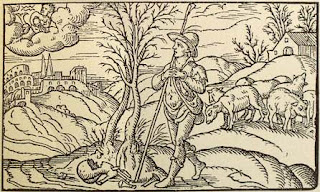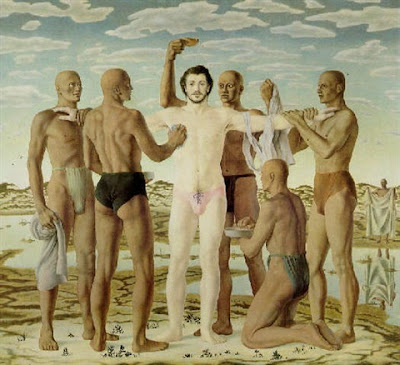Afriboy, The Book of Repentance.
Daler 3404, as it appears
on the web, contains 44 illustrations by Orokie. The original notebook has 80
paintings/ink works – in other words, almost 50% is missing. After 5 pages of
familiar work that shows African faces and evokes African tradition, the web
version jumps to an illustration of two, stylised faces and a single line of
words:
“The world was all before
them.”
The quotation from the
concluding lines of Milton’s Paradise Lost hints at what has been omitted: 6
pages that sketch the psychodrama behind the notebook. These notes describe the
structure of Dante’s Divina Commedia and Milton’s Paradise Lost.
In effect, Orokie is
presenting his work as an epic, a dialogue that considers his own fall and
descent into mental and visual darkness, and his return to life (having ventured into the Underworld). In the missing pages,
Orokie illustrates three out of the four lines that close Paradise Lost, Book
XII. He does not consider the line that refers to Providence and God’s
goodness. His journey is not Christian. He does not take the Bible as his
guide. And he recasts Adam and Eve as Adam and Adam, as two same-sex lovers. This is hinted at in the
public version of Daler 3404:
This peculiar cropping of
Daler 3404 suggests that whoever complied the book did so with a partial view.
He selected certain types of images – the homoerotic – rather than attend to
the themes of the book. Consequently, nothing much makes sense.
In his notes. Orokie
focuses on the central book of Dante’s epic, Purgatorio, and this is
the framework that underlies virtually all of Daler 3404. Orokie’s story
re-imagines Dante and Virgil as they cross Lethe, the river of memory loss. Orokie’s source texts are the original Italian version and Dante’s Purgatory as
translated by Longfellow. References to these sources edge the watercolour.
Something else that is not clear is the colour palette
used by Orokie. Again, this is a result of cropping. As vision returned to
Orokie, he seemingly linked the primacy of vision with primary colours: red, yellow, blue
echo the works of Mondrian and that painter's hermetic, colour vocabulary. The
psychic drama is set on Mount Purgatory (with an intended pun on sexual
mounting); more precisely, the location is the first terrace of Pride, where those who
have misdirected love towards harming others wander with stones above their
heads.
Daler 3404 is a book of penance and humility. It is a book of struggles in which Orokie remembers to paint, to atone through artistic tones, to express the redemptive nature
of kinship, and bring back into memory signs, symbols, styles, and people who were known before his accident - those who cared for him and helped him to recover.
Here, the warrior-lover carries a phallic sword and like St. Sebastian he is pierced by arrows of (Mondrian) vision. (It is worth noting that Piet, as in Piet Mondrian, derives from the Greek for "rock"). The flighted arrows are beginning to resemble wings, an indication that wounds heal and out of trauma new life is born. Tellingly, in this illustration, light radiates from the navel, Orokie's osotwa, the psychic link between two male lovers.
Daler 3404 is a work of tremendous introspection and human courage. The Divine Comedy, in a way, is merged with comic books, to create a narrative about an afterlife on Earth.
(If any reader wishes to contribute to this debate, please email artmercurialmm@aol.com)
Daler 3404 is a work of tremendous introspection and human courage. The Divine Comedy, in a way, is merged with comic books, to create a narrative about an afterlife on Earth.
(If any reader wishes to contribute to this debate, please email artmercurialmm@aol.com)







Comments